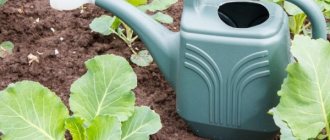Crispy cabbage has firmly established itself in our diet for a reason, because among the widest variety of garden crops, this low-calorie product is a real storehouse of vitamins and microelements. It has been known since time immemorial, and received its name from the ancient Roman word “caputum”, meaning “head”. And in Rus' this vegetable had a figurative nickname - “garden head”. Today it is difficult to meet a gardener who does not grow cabbage - white heads can be seen behind almost every country fence. Growing this beauty so that the forks are dense and the leaves are juicy and crisp is actually not difficult if you know some rules.
When can cabbage seedlings be planted in the ground?
Traditional cultivation of cabbage from seeds involves obtaining it from seedlings, which are then planted in garden beds. The timing of planting grown cabbage seedlings depends on the region and weather conditions, the type of crop and variety, since each of them has its own level of frost resistance. The most cold-resistant cabbage is savoy cabbage, and the most heat-loving cabbage is cauliflower and broccoli. The rest - white and red cabbage, kohlrabi, Brussels sprouts, Beijing sprouts and decorative ones - are somewhere in the middle in terms of frost resistance. Therefore, cabbage can be planted in beds approximately 1-2 months after the seeds germinate.
In the central zone of the Russian Federation, cold-resistant types of cabbage can be planted at the beginning of May, and more heat-loving ones - at the end of this month. In the northern regions, seedlings need to be planted in the beds 7-14 days later, and in the southern regions, respectively, 7-14 days earlier.
The date for planting cabbage can be determined by the air temperature, which should be at least 15-18 °C during the day and 5 °C at night. The soil should be well warmed up; in cold soil, cabbage seedlings will take a long time to take root.
According to popular belief, cabbage should be planted after the bird cherry blossoms, during the flowering of which a cold snap is often observed. It is best to do this on a waxing moon, which, according to amateur gardeners, will contribute to the rapid growth of seedlings planted in the ground.
An indication that cabbage seedlings can already be planted in the beds can be the development of 2 true leaves and the appearance of the 3rd and 4th in the middle. It is acceptable if the plants have more leaves - 4-5 pieces, the height of the seedlings should be at least 10 cm.
What kind of soil does cabbage like when planting?
In order to grow a good harvest of cabbage, you need to choose the right place to plant it . Much depends on where your dacha is located. So which plot should you choose to reap a rich harvest later? Independent choice is good, but it is better to listen to the advice of experienced gardeners. The best solution is a river floodplain, where the roots of a moisture-loving plant are provided with an abundant supply of water. The soil for this garden crop can be of any type with an alkaline or neutral reaction. Cabbage will definitely love this kind of soil. Acidic soil is absolutely not suitable for growing cabbage, as it increases the likelihood of the vegetable being damaged by clubroot. If the soil on your site is acidic, then before growing cabbage, it must be limed.
The soil for growing cabbage seedlings has a lot of requirements.
Dolomite flour is considered the best deoxidizing agent. It contains not only calcium, which reduces acidity, but also magnesium, which has a beneficial effect on the quality of vegetable products and promotes the accumulation of sugars. Dolomite (limestone) flour is added in the spring, right before planting cabbage. But fluff lime needs to be added in the fall.
The soil for the greenhouse is prepared from a mixture of turf soil or peat with humus in equal proportions, and a small amount of wood ash is also added here. The soil mixture is poured into the greenhouse in a layer 10 cm thick or more. The optimal size of a greenhouse for cabbage seedlings is 3x1.5, although this is not critical.
Preparing the bed for growing
Before planting seedlings in open ground, beds are prepared for them. Choose a place for cabbage that is open, sunny, ventilated, but without drafts or strong winds blowing through it. The soil should be soft, loose, moist, but not wet, because cabbage loves moisture, but does not tolerate “swamp”. It is desirable that such a site should previously have grown crops belonging to the legume, nightshade and pumpkin families, as well as root vegetables, but not cabbage itself.
The beds for cabbage have been prepared since the fall:
- The remnants of the previously growing crop and weeds are removed from the ground.
- Then they dig it up to a depth of no less than 30 cm.
- At the same time, organic matter is added to each m2 of land - 5 kg of well-rotted humus or compost.
- If the soil is acidic, it is neutralized with chalk or lime.
In the spring, the beds are dug up again and minerals are added to the soil - 1 tbsp. l. saltpeter and superphosphate, with the addition of 1 cup of ash per 1 m2. To save fertilizer, you can put it in the hole when planting cabbage. In this case, pour 1 tablespoon of ash and two handfuls of rotted compost, as well as 1 tsp. into each planting hole. nitroammofoski. Mix everything thoroughly with the soil.
Planting seedlings in open ground: planting scheme
Seedlings begin to be prepared for planting 10 days before planting in the ground. At this time, the plants are hardened off. If they grow in a greenhouse, open the doors and windows every day for 30 minutes at first, increasing the hardening time daily. If seedlings are grown in an apartment, then cassettes or pots with them are taken out to the balcony.
2 weeks before planting in the beds, cabbage seedlings are fed with minerals - add 1 tbsp to 10 liters of water. l. nitrate and potassium sulfate. 150 ml of solution is used for each young plant. 2 days before planting, stop watering the seedlings so that their stems become a little drier and do not break when trying to plant the cabbage in the ground. Just before planting, the plants are watered so that they can be removed from the containers in which they grew.
Choose one of the favorable days for planting cabbage and start planting seedlings in open ground, on a cloudy day, preferably in the morning or evening.
Cabbage is planted according to a 40 by 50 cm pattern. This area is sufficient for growing early varieties of the white cabbage variety of this vegetable and kohlrabi. Other types of crops are planted using a different scheme for planting cabbage in open ground: Peking cabbage is placed in beds with an interval of 30 by 30 cm, other cabbages and late varieties of white cabbage - 60 by 60 cm.
Holes for cabbage should be made at least 15 cm deep so that the plants have enough nutrients for growth and development. After they are done, 1-2 liters of warm water, heated in the sun, are poured into them so that the earth becomes sufficiently moist. When it is absorbed, add a glass of humus and 10 g of ash (matchbox) to the holes and sprinkle a little earth on top.
Cabbage seedlings are taken out with a lump of earth, and then one copy at a time is placed in the holes, covered with soil and compacted a little. When planting cabbage seedlings, it is buried in the ground to such a depth that the roots are completely closed and the rosette of leaves remains open. You cannot sprinkle it with soil, otherwise the growth of leaves in it will be delayed or stop altogether. After all the cabbage has been planted, it is watered again and covered with earth so that the soil layer does not crack.
Cabbage tolerates proximity to other vegetables well, so you can compact the plantings with onions, lettuce, spinach and get a double harvest from the same area.
Watering
After planting, young seedlings are watered once every 3-4 days for the first two weeks. Water consumption is about 5-7 l/m2. This pattern may change to suit weather conditions. On dry days, the time run should be reduced; in rainy and cloudy weather, on the contrary, it should be increased. When the sun is especially scorching, it is recommended to “pamper” cabbage with sprinkling, but only in the early morning or evening hours.
The need for watering at different stages of the growing season is not the same. Not only the water consumption rates and the depth of soil moisture change, but also the frequency. Early varieties are watered more abundantly in June, when the rosette is actively forming, late varieties - in August for the same reason. The lack of water subsequently affects the size of the head of cabbage, even if the beds are watered correctly in the subsequent period.
When watering is carried out rarely, but at double rates, the seedlings try to compensate for the moisture deficit by growing the root system deeper. This, in turn, leads to improper distribution of energy within the plant and, as a result, reduced yield. When watering is carried out regularly and in doses, the roots are located near the surface of the earth and take from there all the necessary nutrients. With this development, cabbage receives the full range of mineral and organic fertilizers, which contributes to the formation of heads of the desired size, corresponding to the given variety.
Related article:
The best cabbage varieties for long-term storage
Watering must be done in the morning or evening with water, the temperature of which varies between +18 +23 °C. It is advisable to loosen the soil regularly, saturating it with oxygen and removing weeds. The depth of loosening should be approximately 5-8 cm - shallower at the root, deeper between the rows.
Caring for planted seedlings
In the first days after the seedlings are planted, they are shaded from the sun and protected from the night cold with a film that is stretched over the cabbage beds on arches made of thick wire. When it takes root, which will happen after about 1-2 weeks, the film is removed.
Water the planted seedlings every 2-3 days with 2-3 liters of settled warm water under each plant. This watering scheme is followed for a month, and then the cabbage is watered 2 times a week if the weather is warm and 1 time if it is cool. Watering is done in the early morning or late evening so that the roots of the seedlings can receive moisture from the moist soil for as long as possible.
Loose the soil after each watering or heavy rain to break the crust and give air to the roots. At the same time, carefully sprinkle the roots of the plants with soil if they were bare.
Fertilizing is another mandatory condition for caring for cabbage in open ground:
- The first of them is carried out 14 days after planting the seedlings. Use complex complex fertilizers, saturated with macro- and microelements or infusions of fresh mullein (1 to 10), poultry droppings (1 to 20). 0.5 liters of fertilizer is poured under each cabbage plant.
- The 2nd feeding is carried out 14 days after the first. This time they use a mixture of 3 mineral components - nitrate, potassium chloride and superphosphate (1: 1: 2). Dry granules are mixed and the mixture is sprinkled on the ground at the rate of 50 g per m2 of beds, then watered.
- The 3rd feeding is done after another 2 weeks. Take 4 g of superphosphate, 2 g of potassium salt and dilute it in 1 liter of water.
To prevent pests (aphids, snails, slugs) from appearing on cabbage, the soil near each plant is sprinkled with ash - 1 cup is scattered over an area of 1 m2.
Alternative agricultural techniques
Traditional methods of growing vegetables have been studied quite well, but gardeners are striving to use new and unusual techniques. With their help, you can also achieve decent yields.
Growing from stalks
In areas with a warm climate, you can get a second harvest of early cabbage if you use the stalk as planting material.
To do this, when cutting heads of cabbage, they try to preserve the stem as much as possible. They don’t pull it out, continuing to water, feed, and loosen it. As the heads of cabbage form, you need to remove excess specimens. Two forks can develop on one stalk.
The lower leaves are left as they help retain moisture in the soil. By autumn, forks are formed. They will be smaller, but in taste and quality they are not inferior to the first harvest.
Growing without watering
The most labor-intensive operation when cultivating cabbage is considered to be frequent application of moisture. It will not be possible to do without watering completely throughout the growing season, but you can apply some agrotechnical techniques aimed at significantly reducing the number of these procedures:
- Formation of high ridges in the autumn at the stage of tillage in the area allocated for cabbage. They will serve to retain snow.
- Lack of deep digging of beds. Surface loosening of the soil is practiced to remove soil crust.
- Use seed cultivation technology when possible. Seedlings that have not been transplanted form a more powerful root system, allowing them to receive moisture from deeper soil layers.
- Planting varieties with high drought resistance.
- Mulching beds.
Under plastic bottles
When sowing directly into the garden bed, it is important to protect the seedlings from a possible drop in temperature. It is convenient to use plastic containers as a local miniature shelter. Under bottles that retain moisture and heat, the seeds hatch faster. Young plants receive protection from harmful insects .
Holes are formed in the beds where seeds are planted. After watering, install capped bottles with the bottoms cut off, burying the lower part a little into the soil for safety. Watering and ventilation is carried out by unscrewing the lid. Remove the cover when the leaves already fill the inside of the bottle.
Cabbage under film
To accelerate the development of seedlings, preserve moisture, and slow down the growth of weeds, mulch is used. Her role is successfully played by black film.
The beds are formed 30 days before the planned planting. After leveling, a film is spread on the surface. The edges are secured with cobblestones, bricks or other available materials. The soil under such shelter warms up well.
Before planting, in accordance with the chosen pattern, cross-shaped cuts are made in the film. Holes are made under them and seedlings are placed.
Direct sowing of seeds in the ground under plastic bottles
This is an alternative method of growing cabbage that can be used by gardeners in the southern regions of the Russian Federation. In this case, plastic bottles will play the role of mini-greenhouses for each individual plant. 1.5-2 liter transparent bottles are suitable, the bottom of which is cut off, but the lids are left on.
Before sowing, seeds are soaked for 30 minutes in a solution of potassium permanganate to disinfect them, and then washed in clean running water. Afterwards, they are left in a wet cloth for germination for 1 day.
The beds are prepared for seeds in the fall and spring in the same way as for seedlings, but in this case they are made narrow and tall. Holes for cabbage are made using a glass bottle of suitable size. Use it to press even round holes, pour 2 tbsp into them. l. ash, water it, and then sow seeds there. When planting cabbage, place 3-4 of them in each hole, because not all seeds germinate equally well. They are carefully sprinkled on top with a thin layer of dry earth or humus, and then a bottle with a screwed cap is placed in each hole. In the intervals between the plants, fast-growing greens are sown - dill or lettuce, which can be cut before the plants under the bottles grow up.
When sowing cabbage in open ground, water the seeds through the neck of the bottle, opening the lids for a while. After some time, check how the seeds have sprouted. If it turns out that several have sprouted in a single hole, then 1 plant, the strongest one, is left in it, and the rest are removed or, if possible, planted in other beds. Watering and fertilizing are carried out in exactly the same way as in the case of seedlings. When the plants under the bottles have grown and become strong enough, the greenhouses are removed.
Tips and recommendations from experienced gardeners
Those who have grown white cabbage in the countryside note that there are several techniques that will improve the quality of planting seedlings or seeds in open beds.
For example, if the seedlings have outgrown and become too large, when planting the plants, you need to tear off the upper halves of the leaves. This way they will settle down faster and get sick less. But this must be done carefully so as not to accidentally cut off the growing point, otherwise there will be no heads of cabbage.
You need to plant strictly 1 plant in each hole, and when sowing seeds, leave only one. Otherwise, cabbages growing together will have small and ugly heads.
Slightly frozen plants due to return frosts can be sprayed with Epin or Novosil solutions.
We recommend reading
What varieties of cabbage to choose for pickling, pickling and storing for the winter
How can you feed cabbage after planting in the ground?
Methods for storing cabbage in the cellar and at home
Methods, terms and conditions for storing cauliflower
Making a nursery
White cabbage should be grown as seedlings. To do this you need to make a nursery. The nursery should be made in a bright place protected from the wind. To begin, we make a box 1 meter wide, 1.5 meters long and 50 centimeters high. We lay a layer of manure on the bottom, and pour about 20 centimeters of earth on top. We loosen the earth so that there are no lumps and pour boiling water over it (to kill harmful substances). Cover tightly with film and leave for several days so that the earth warms up well.











